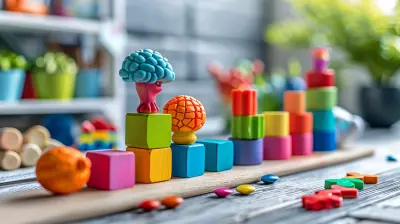Exploring Mindfulness Techniques to Enhance Student Focus
23 June 2025
Let’s face it—staying focused as a student nowadays feels like trying to juggle flaming swords on a unicycle. There’s always something buzzing, pinging, or popping up to steal our attention. Whether it’s your phone, social media, or just an overactive mind, distractions are everywhere.
But here's the silver lining: mindfulness. This simple, powerful practice can bring calm to the chaos, helping students not just stay focused—but thrive.
In this article, we’re diving deep into the world of mindfulness techniques specifically tailored to help students sharpen their focus, boost their academic performance, and feel more in control of their lives. Ready? Let’s breathe in, focus, and begin.
What is Mindfulness, Really?
Mindfulness isn’t about sitting cross-legged on a mountain in total silence (unless that’s your thing). It's about being fully present in the moment—aware of what you're doing, thinking, and feeling—without judgment.Think of your brain like a browser. You’ve got 20 tabs open, music playing, a pop-up ad jumping in, and your mouse is lagging. Mindfulness closes the unnecessary tabs so you can zero in on what you actually need to do. Simple, right?
Why Do Students Struggle With Focus?
Before we jump into the how, let's chat about the why.Students today are living in one of the most stimulating environments in human history. Between endless notifications, the pressure to perform, and the constant comparison game on social media, it's no wonder focus is slipping away.
Here are a few common culprits:
- Information overload
- Constant multitasking
- Stress and anxiety
- Lack of proper sleep
- Poor time management
Mindfulness isn't a magic pill, but it gives students the tools to cut through the noise and regain control.
The Science Behind Mindfulness and Focus
You don’t need a lab coat to appreciate the science here.Studies have shown that mindfulness can strengthen the brain’s prefrontal cortex—the part responsible for decision-making, attention, and emotional regulation. Regular practice actually thickens this area, improving cognitive function.
In simpler terms? The more you practice mindfulness, the more your brain is wired for focus. And who doesn’t want that?
Simple Mindfulness Techniques for Students
Okay, enough talk. Let’s roll up our sleeves and get into some actual techniques. These are practical, beginner-friendly and designed with a student’s schedule in mind.1. Focused Breathing (aka the 3-Minute Miracle)
You always have your breath with you, which makes this the perfect on-the-go mindfulness tool.How to do it:
1. Sit comfortably.
2. Close your eyes.
3. Inhale deeply through your nose for 4 seconds.
4. Hold for 2 seconds.
5. Exhale slowly through your mouth for 6 seconds.
6. Repeat for 3 minutes.
Focused breathing hacks your nervous system and pulls you out of stress mode. It’s like hitting the reset button on your brain.
2. The Body Scan
This one’s great for when you’re feeling scattered or physically tense (hello, all-nighters).How to do it:
- Lie down or sit comfortably.
- Close your eyes.
- Start at the top of your head and slowly move your attention down your body.
- Notice how each part feels—without trying to change anything.
You’re not fixing anything; you’re just noticing. And that act of noticing centers your mind.
3. Mindful Walking
Yep, even walking can be a mindfulness exercise.How to do it:
- Walk slowly and deliberately.
- Pay attention to each step.
- Feel the ground beneath your feet.
- Listen to the sounds around you.
- Avoid distractions—no phones!
Perfect between classes, or as a brain break when studying gets intense.
4. The 5-4-3-2-1 Technique
This is a grounding exercise that pulls your mind back from a spiral and into the now.Here’s how it works:
- Name 5 things you can see.
- Name 4 things you can touch.
- Name 3 things you can hear.
- Name 2 things you can smell.
- Name 1 thing you can taste.
It’s like CPR for your attention span.
5. Journaling the Mindful Way
Sometimes, letting your thoughts spill out is the best way to focus them.Try This:
- Set a timer for 10 minutes.
- Write about your day, your thoughts, or how you’re feeling—without editing or judging.
- Just keep the pen moving.
This helps declutter your brain so you can get back to what matters.
Bringing Mindfulness into the Classroom
Students aren’t the only ones who benefit—teachers, take note! Integrating mindfulness into the daily routine can create a more focused, peaceful, and productive classroom environment.A few easy ways to start:
- Begin class with 2 minutes of silence or deep breathing.
- Encourage students to pause and reflect before answering questions.
- Use mindfulness as a transition between subjects.
It doesn’t have to be hippie-dippy or complicated. Just a few mindful moments can change the energy of the whole room.
How Mindfulness Improves Academic Performance
Here’s where things get exciting.Studies show that students who practice mindfulness regularly report:
- Improved concentration and memory
- Reduced stress and anxiety
- Better problem-solving skills
- Stronger emotional regulation
So if you're a student thinking, “But I don’t have time for this,” keep in mind that these few minutes a day could actually save you hours of lost focus and productivity.
Making Mindfulness a Habit
We’ve all been there—excited to try something new, only to fall off the wagon a few days later.So how do you stick with mindfulness?
- Start small – Even 2 minutes a day is a win.
- Pick a trigger – Tie your practice to a daily activity (like brushing your teeth or riding the bus).
- Use tech wisely – Try mindfulness apps like Headspace or Insight Timer.
- Track your progress – A simple habit tracker can be super motivating.
- Don’t judge yourself – Miss a day? No big deal. Just start again.
Remember, mindfulness isn’t about doing it perfectly. It’s about showing up.
Real Students, Real Stories
Let’s hear it straight from the source.Maria, a college sophomore, shared:
_"I used to get crippling test anxiety. Since I started doing mindful breathing before exams, it’s like my brain unclenches. I don’t panic anymore. I think more clearly."_
Jared, a high school senior, said:
_"Focusing during lectures was impossible. Now I practice mindfulness walking during lunch, and afterwards, I’m way more alert and calm."_
That’s the kind of everyday magic mindfulness can offer.
Final Thoughts: Mindfulness Isn’t a Trend—It’s a Tool
Sure, mindfulness might be trending, but it’s not just some buzzword. It’s a life skill. For students feeling overwhelmed, distracted, and mentally drained, mindfulness is the flashlight in the dark.The best part? You don’t need fancy gear. No expensive programs. Just your breath, your mind, and a few minutes a day. That’s it.
So next time your brain’s bouncing like a ping-pong ball, pause. Breathe. Be here.
Making mindfulness a daily habit won’t happen overnight, but with baby steps, it can become the secret weapon in your student success toolkit.
Quick Recap: Top Mindfulness Techniques for Students
- 🧘 Focused Breathing- 🛌 Body Scans
- 🚶 Mindful Walking
- 🌈 5-4-3-2-1 Grounding
- ✍️ Journaling
Incorporate even one of these, and you’ll notice a shift. Stack a couple together, and you might just find yourself mastering focus like a monk with a backpack.
all images in this post were generated using AI tools
Category:
Student EngagementAuthor:

Olivia Lewis
Discussion
rate this article
2 comments
Erin Cruz
This article sparks my curiosity about mindfulness in education! I'm eager to learn how these techniques can reshape student focus and engagement. Can't wait to explore practical applications and hear success stories from educators!
November 7, 2025 at 5:07 AM

Olivia Lewis
Thank you for your enthusiasm! I'm excited for you to discover how mindfulness can positively impact student engagement and focus in the classroom. Stay tuned for practical applications and inspiring success stories!
Dahlia Kirkland
Mindfulness techniques significantly improve student focus, engagement, and academic performance.
June 24, 2025 at 1:03 PM

Olivia Lewis
Thank you for your comment! Indeed, mindfulness techniques can be powerful tools for enhancing focus and engagement in students.


